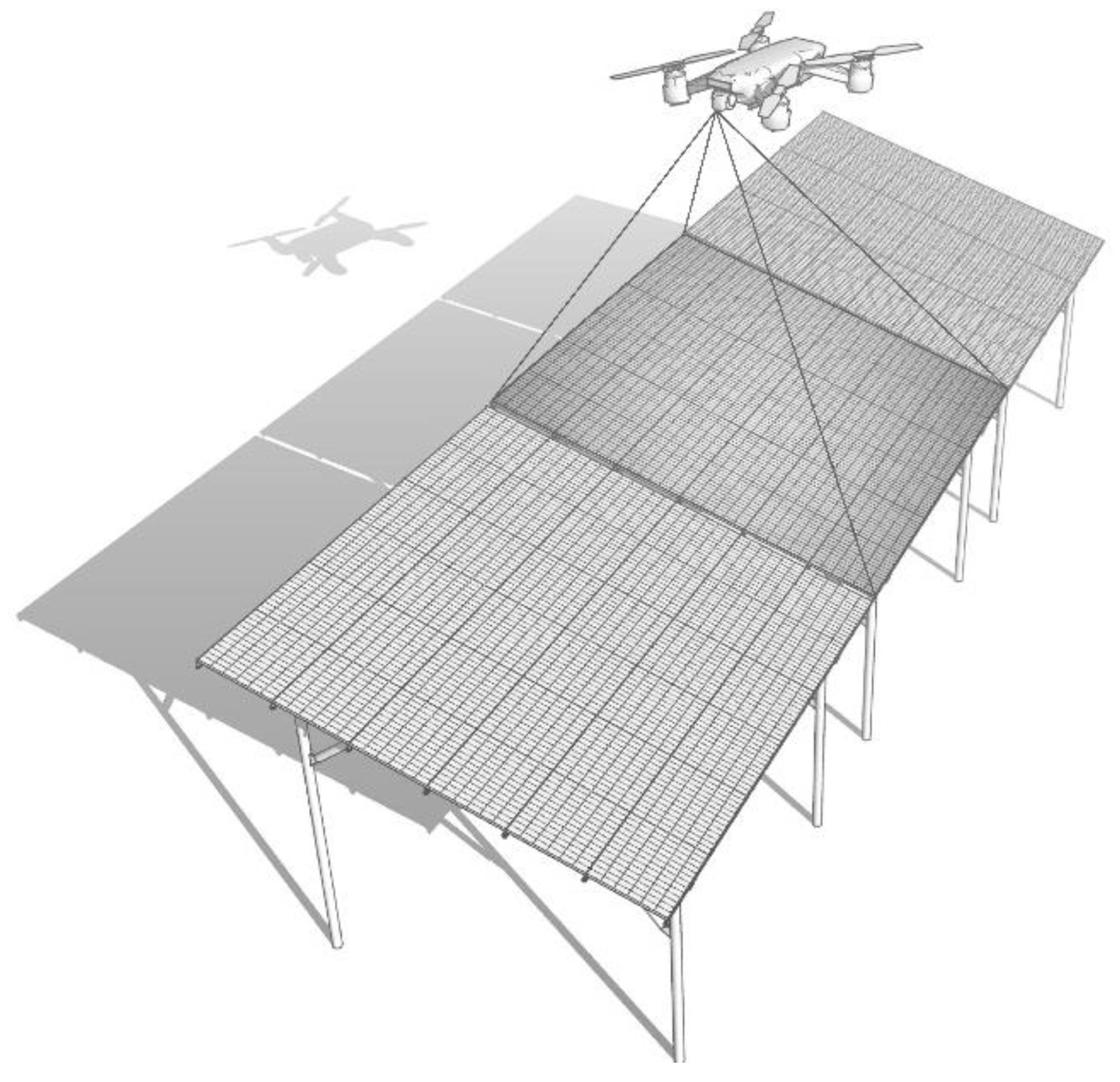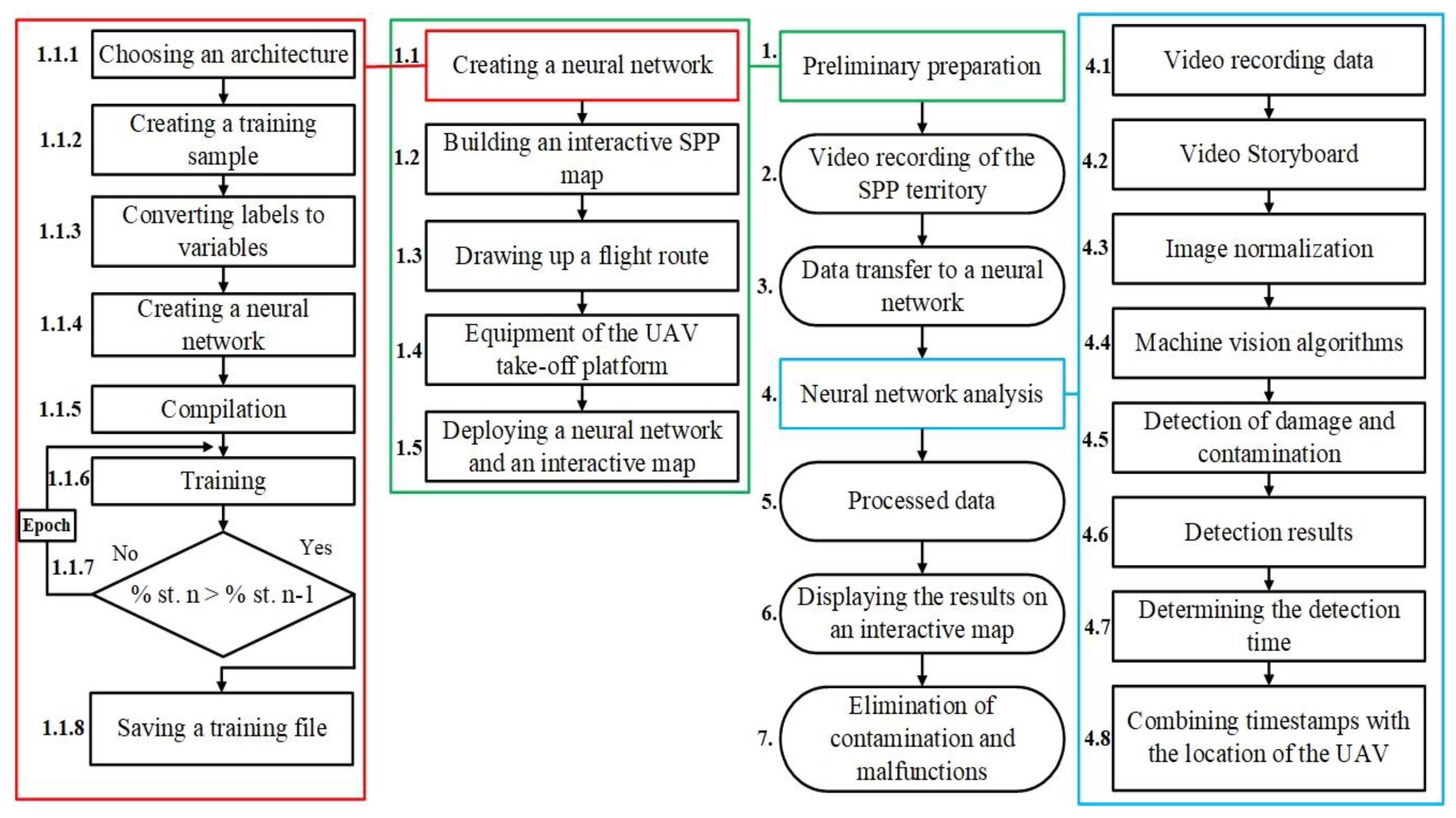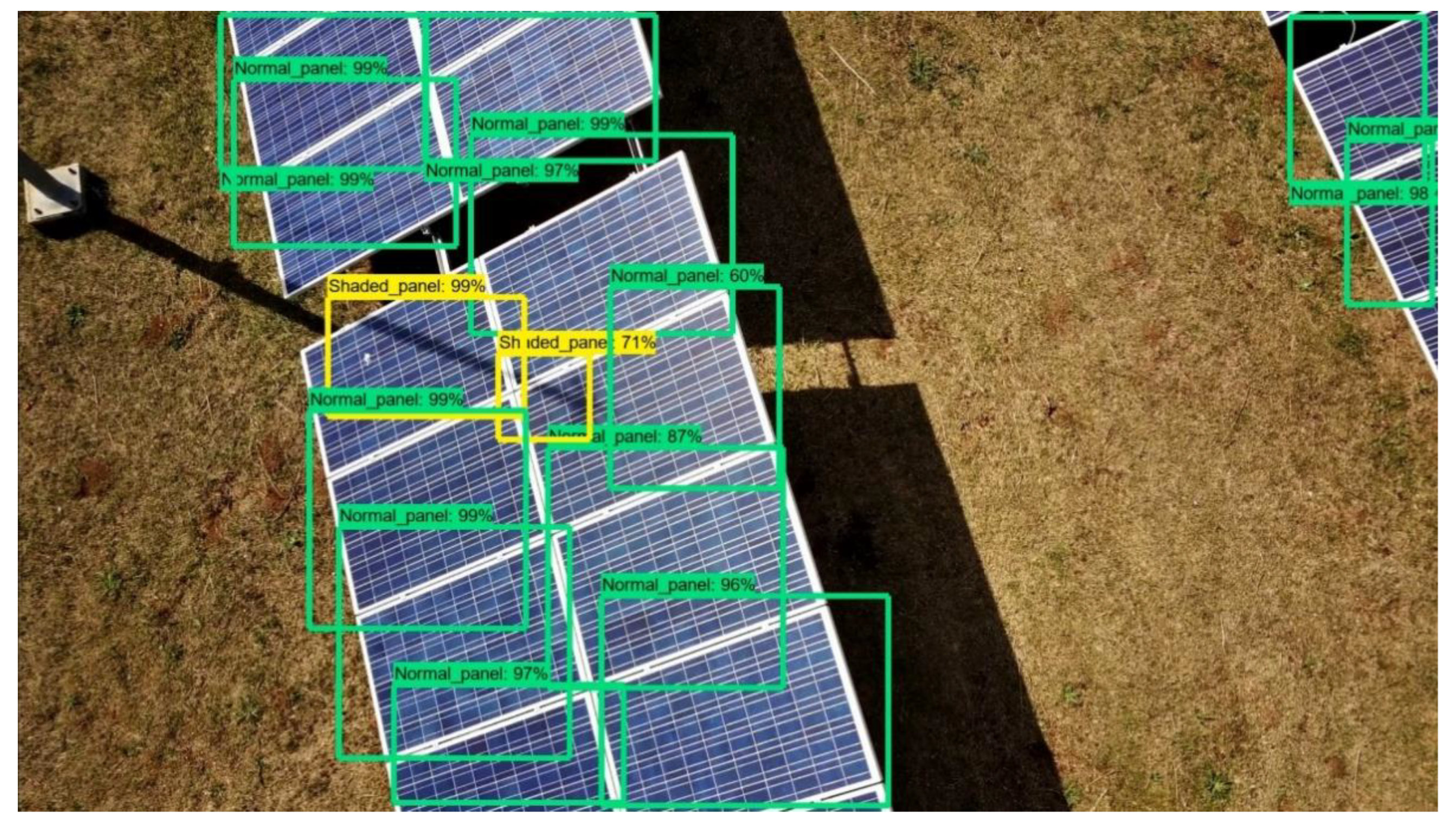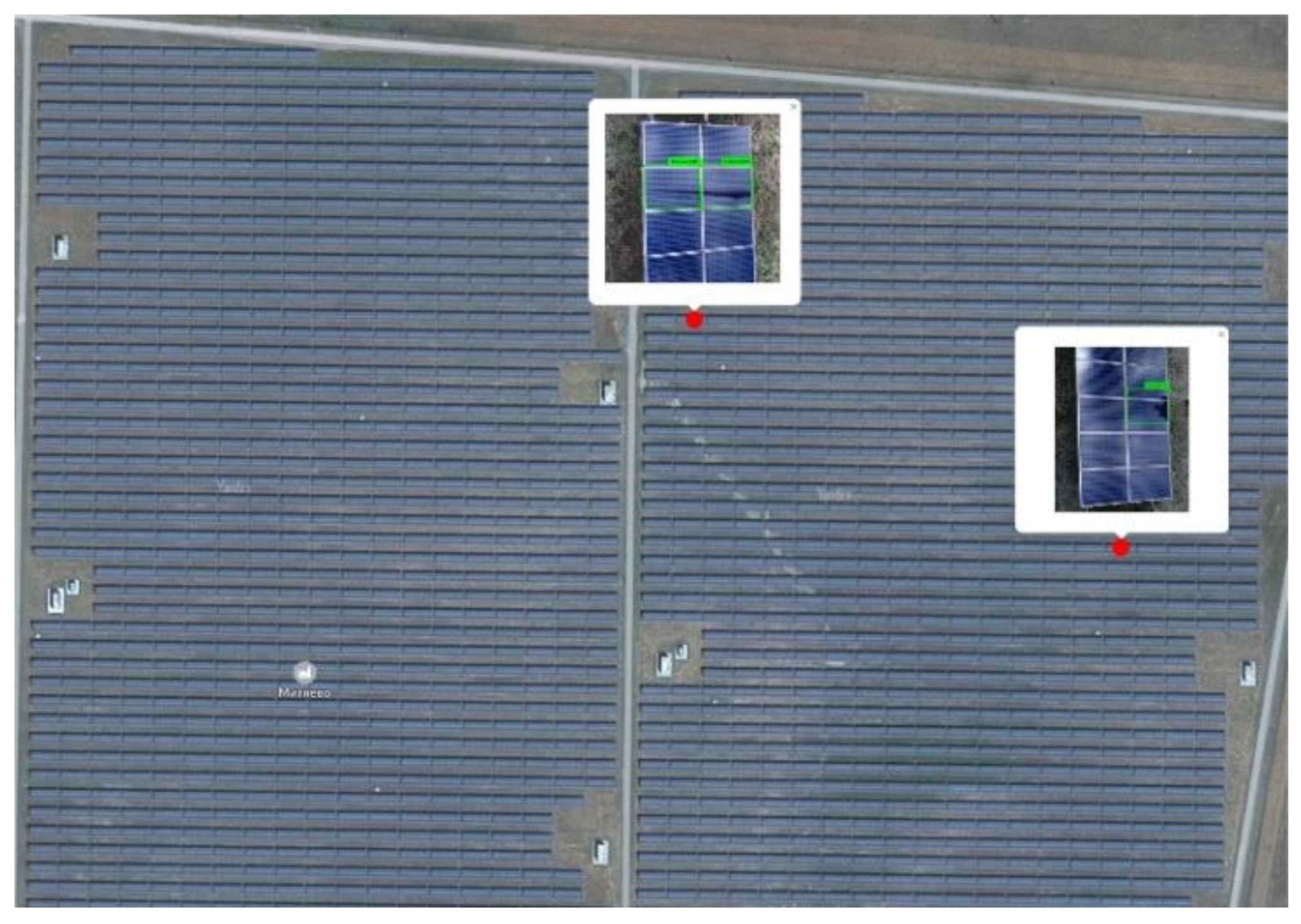Method for the Automated Inspection of the Surfaces of Photovoltaic Modules
Abstract
1. Introduction
2. Materials and Methods
2.1. Existing Methods of Neural Network Monitoring and Diagnostics Photovoltaic Modules
2.2. Platform for Employing an Automated Complex
2.3. Choice of Neural Network Architecture
2.4. Creating a Training Sample
- The video recording of photovoltaic modules should be carried out by a UAV camera at a height of up to five meters at an angle of 90° to 135° to the surface of the modules, when flying directly over the string (Figure 1).
- When video recording the surface of photovoltaic modules, the automatic exposure function must be disabled in the UAV camera settings. This is necessary to preserve details in light and dark areas (in the case of an underexposed and overexposed image at various lighting parameters).
- Video recording of the photovoltaic modules should be carried out on a clear day at a wind speed of no more than 4 m/s. This is necessary to ensure normal conditions for the UAV flight route.
3. Discussion
4. Results
5. Conclusions
Author Contributions
Funding
Institutional Review Board Statement
Informed Consent Statement
Data Availability Statement
Conflicts of Interest
References
- Silverman, T.J.; Mansfield, L.; Repins, I.; Kurtz, S. Damage in Monolithic Thin-Film Photovoltaic Modules Due to Partial Shade. IEEE J. Photovolt. 2016, 6, 1333–1338. [Google Scholar] [CrossRef]
- Paul, D.I. Dust Deposition on Photovoltaic Modules: Its Effects on Performance. In The Effects of Dust and Heat on Photovoltaic Modules: Impacts and Solutions; Springer: Berlin/Heidelberg, Germany, 2022; pp. 3–46. [Google Scholar]
- Al Siyabi, I.; Al Mayasi, A.; Al Shukaili, A.; Khanna, S. Effect of Soiling on Solar Photovoltaic Performance under Desert Climatic Conditions. Energies 2021, 14, 659. [Google Scholar] [CrossRef]
- Kuznetsov, P.; Yuferev, L.; Voronin, D.; Panchenko, V.A.; Jasiński, M.; Najafi, A.; Leonowicz, Z.; Bolshev, V.; Martirano, L. Methods Improving Energy Efficiency of Photovoltaic Systems Operating under Partial Shading. Appl. Sci. 2021, 11, 10696. [Google Scholar] [CrossRef]
- Nalamwar, H.S.; Ivanov, M.A.; Baidali, S.A. Automated Intelligent Monitoring and the Controlling Software System for Solar Panels. J. Phys. Conf. Ser. 2017, 803, 012107. [Google Scholar] [CrossRef]
- Kuznetsov, P.N.; Lyamina, N.V.; Yuferev, L.Y. A Device for Remote Monitoring of Solar Power Plant Parameters. Appl. Sol. Energy 2019, 55, 247–251. [Google Scholar] [CrossRef]
- Kumar, N.M.; Sudhakar, K.; Samykano, M.; Jayaseelan, V. On the Technologies Empowering Drones for Intelligent Monitoring of Solar Photovoltaic Power Plants. Procedia Comput. Sci. 2018, 133, 585–593. [Google Scholar] [CrossRef]
- Kuznetsov, P.N.; Kotelnikov, D.Y. Automated Complex of Intelligent Monitoring of a Solar Power Plant. J. Phys. Conf. Ser. 2021, 2094, 052025. [Google Scholar] [CrossRef]
- Tina, G.M.; Cosentino, F.; Ventura, C. Monitoring and Diagnostics of Photovoltaic Power Plants. In Renewable Energy in the Service of Mankind; Springer International Publishing: Cham, Switzerland, 2016; Volume II, pp. 505–516. [Google Scholar]
- Coleman, A.; Zalewski, J. Intelligent Fault Detection and Diagnostics in Solar Plants. In Proceedings of the 6th IEEE International Conference on Intelligent Data Acquisition and Advanced Computing Systems, Prague, Czech Republic, 15–17 September 2011; IEEE: Piscataway, NJ, USA, 2011; pp. 948–953. [Google Scholar]
- Beránek, V.; Olšan, T.; Libra, M.; Poulek, V.; Sedláček, J.; Dang, M.-Q.; Tyukhov, I. New Monitoring System for Photovoltaic Power Plants’ Management. Energies 2018, 11, 2495. [Google Scholar] [CrossRef]
- Libra, M.; Daneček, M.; Lešetický, J.; Poulek, V.; Sedláček, J.; Beránek, V. Monitoring of Defects of a Photovoltaic Power Plant Using a Drone. Energies 2019, 12, 795. [Google Scholar] [CrossRef]
- Jayas, D.S.; Paliwal, J.; Visen, N.S. Review Paper (AE—Automation and Emerging Technologies). J. Agric. Eng. Res. 2000, 77, 119–128. [Google Scholar] [CrossRef]
- Sietsma, J.; Dow, R.J.F. Creating Artificial Neural Networks That Generalize. Neural Netw. 1991, 4, 67–79. [Google Scholar] [CrossRef]
- Sarle, W.S. Neural networks and statistical models. In Proceedings of the Nineteenth Annual SAS Users Group International Conference, Dallas, TX, USA, 10–13 April 1994; SAS Institute Inc.: Cary, NC, USA, 1994; pp. 1538–1550. [Google Scholar]
- Kalogirou, S.A. Artificial Neural Networks in Renewable Energy Systems Applications: A Review. Renew. Sustain. Energy Rev. 2001, 5, 373–401. [Google Scholar] [CrossRef]
- Kalogirou, S.A. Applications of Artificial Neural-Networks for Energy Systems. Appl. Energy 2000, 67, 17–35. [Google Scholar] [CrossRef]
- Mo, K.; Lee, S.J.; Seong, P.H. A Dynamic Neural Network Aggregation Model for Transient Diagnosis in Nuclear Power Plants. Prog. Nucl. Energy 2007, 49, 262–272. [Google Scholar] [CrossRef]
- Guo, Y.; Gong, C.; Zeng, H.-Y. The Application of Artificial Neural Network in Nuclear Energy. In Proceedings of the 2010 International Conference on Machine Learning and Cybernetics, Qingdao, China, 11–14 July 2010; IEEE: Piscataway, NJ, USA, 2010; pp. 1244–1248. [Google Scholar]
- Ferrero Bermejo, J.; Gómez Fernández, J.F.; Olivencia Polo, F.; Crespo Márquez, A. A Review of the Use of Artificial Neural Network Models for Energy and Reliability Prediction. A Study of the Solar PV, Hydraulic and Wind Energy Sources. Appl. Sci. 2019, 9, 1844. [Google Scholar] [CrossRef]
- El-Abbasy, M.S.; Senouci, A.; Zayed, T.; Mirahadi, F.; Parvizsedghy, L. Artificial Neural Network Models for Predicting Condition of Offshore Oil and Gas Pipelines. Autom. Constr. 2014, 45, 50–65. [Google Scholar] [CrossRef]
- Tao, X.; Zhang, D.; Wang, Z.; Liu, X.; Zhang, H.; Xu, D. Detection of Power Line Insulator Defects Using Aerial Images Analyzed with Convolutional Neural Networks. IEEE Trans. Syst. Man Cybern. Syst. 2020, 50, 1486–1498. [Google Scholar] [CrossRef]
- Schlechtingen, M.; Ferreira Santos, I. Comparative Analysis of Neural Network and Regression Based Condition Monitoring Approaches for Wind Turbine Fault Detection. Mech. Syst. Signal Process. 2011, 25, 1849–1875. [Google Scholar] [CrossRef]
- Movsessian, A.; García Cava, D.; Tcherniak, D. An Artificial Neural Network Methodology for Damage Detection: Demonstration on an Operating Wind Turbine Blade. Mech. Syst. Signal Process. 2021, 159, 107766. [Google Scholar] [CrossRef]
- Munawar, H.S.; Ullah, F.; Qayyum, S.; Khan, S.I.; Mojtahedi, M. UAVs in Disaster Management: Application of Integrated Aerial Imagery and Convolutional Neural Network for Flood Detection. Sustainability 2021, 13, 7547. [Google Scholar] [CrossRef]
- Valdez, D.B.; Godmalin, R.A.G. A Deep Learning Approach of Recognizing Natural Disasters on Images Using Convolutional Neural Network and Transfer Learning. In Proceedings of the International Conference on Artificial Intelligence and Its Applications, EL-Oued, Algeria, 28–30 September 2021; ACM: New York, NY, USA, 2021; pp. 1–7. [Google Scholar]
- Huerta Herraiz, Á.; Pliego Marugán, A.; García Márquez, F.P. Photovoltaic Plant Condition Monitoring Using Thermal Images Analysis by Convolutional Neural Network-Based Structure. Renew. Energy 2020, 153, 334–348. [Google Scholar] [CrossRef]
- Haidari, P.; Hajiahmad, A.; Jafari, A.; Nasiri, A. Deep Learning-Based Model for Fault Classification in Solar Modules Using Infrared Images. Sustain. Energy Technol. Assess. 2022, 52, 102110. [Google Scholar] [CrossRef]
- Sohani, A.; Sayyaadi, H.; Miremadi, S.R.; Samiezadeh, S.; Doranehgard, M.H. Thermo-Electro-Environmental Analysis of a Photovoltaic Solar Panel Using Machine Learning and Real-Time Data for Smart and Sustainable Energy Generation. J. Clean. Prod. 2022, 353, 131611. [Google Scholar] [CrossRef]
- Alajmi, M.; Aljasem, O.; Ali, N.; Alqurashi, A.; Abdel-Qader, I. Fault Detection and Localization in Solar Photovoltaic Arrays Framework: Hybrid Methods of Data-Analysis and a Network of Voltage-Current Sensors. In Proceedings of the 2018 IEEE International Conference on Electro/Information Technology (EIT), Rochester, MI, USA, 3–5 May 2018; IEEE: Piscataway, NJ, USA, 2018; pp. 404–410. [Google Scholar]
- Samara, S.; Natsheh, E. Intelligent Real-Time Photovoltaic Panel Monitoring System Using Artificial Neural Networks. IEEE Access 2019, 7, 50287–50299. [Google Scholar] [CrossRef]
- Hu, Y.; Zhang, J.; Cao, W.; Wu, J.; Tian, G.Y.; Finney, S.J.; Kirtley, J.L. Online Two-Section PV Array Fault Diagnosis with Optimized Voltage Sensor Locations. IEEE Trans. Ind. Electron. 2015, 62, 7237–7246. [Google Scholar] [CrossRef]
- Chine, W.; Mellit, A.; Lughi, V.; Malek, A.; Sulligoi, G.; Massi Pavan, A. A Novel Fault Diagnosis Technique for Photovoltaic Systems Based on Artificial Neural Networks. Renew. Energy 2016, 90, 501–512. [Google Scholar] [CrossRef]
- Lopez-Guede, J.M.; Ramos-Hernanz, J.A.; Zulueta, E.; Fernadez-Gamiz, U.; Oterino, F. Systematic Modeling of Photovoltaic Modules Based on Artificial Neural Networks. Int. J. Hydrogen Energy 2016, 41, 12672–12687. [Google Scholar] [CrossRef]
- Ali, R.; Kang, D.; Suh, G.; Cha, Y.-J. Real-Time Multiple Damage Mapping Using Autonomous UAV and Deep Faster Region-Based Neural Networks for GPS-Denied Structures. Autom. Constr. 2021, 130, 103831. [Google Scholar] [CrossRef]
- Ayoub, N.; Schneider-Kamp, P. Real-Time On-Board Deep Learning Fault Detection for Autonomous UAV Inspections. Electronics 2021, 10, 1091. [Google Scholar] [CrossRef]
- Xun, D.T.; Lim, Y.L.; Srigrarom, S. Drone Detection Using YOLOv3 with Transfer Learning on NVIDIA Jetson TX2. In Proceedings of the 2021 Second International Symposium on Instrumentation, Control, Artificial Intelligence, and Robotics (ICA-SYMP), Bangkok, Thailand, 20–22 January 2021; IEEE: Piscataway, NJ, USA, 2021; pp. 1–6. [Google Scholar]
- Chen, Y.M.; Dong, L.; Oh, J.-S. Real-Time Video Relay for UAV Traffic Surveillance Systems Through Available Communication Networks. In Proceedings of the 2007 IEEE Wireless Communications and Networking Conference, Hong Kong, China, 11–15 March 2007; pp. 2608–2612. [Google Scholar]
- Pereira, F.C.; Pereira, C.E. Embedded Image Processing Systems for Automatic Recognition of Cracks Using UAVs. IFAC Pap. Online 2015, 48, 16–21. [Google Scholar] [CrossRef]
- Halawa, H.; Abdelhafez, H.A.; Boktor, A.; Ripeanu, M. NVIDIA Jetson Platform Characterization. In Proceedings of the 23rd International Conference on Parallel and Distributed Computing, Santiago de Compostela, Spain, 28 August–1 September 2017; pp. 92–105. [Google Scholar]
- Suzen, A.A.; Duman, B.; Sen, B. Benchmark Analysis of Jetson TX2, Jetson Nano and Raspberry PI Using Deep-CNN. In Proceedings of the 2020 International Congress on Human-Computer Interaction, Optimization and Robotic Applications (HORA), Ankara, Turkey, 26–28 June 2020; IEEE: Piscataway, NJ, USA, 2020; pp. 1–5. [Google Scholar]
- Bokovoy, A.; Muravyev, K.; Yakovlev, K. Real-Time Vision-Based Depth Reconstruction with NVidia Jetson. In Proceedings of the 2019 European Conference on Mobile Robots (ECMR), Prague, Czech Republic, 4–6 September 2019; IEEE: Piscataway, NJ, USA, 2019; pp. 1–6. [Google Scholar]
- Zoev, I.V.; Markov, N.G.; Ryzhova, S.E. Intelligent Computer Vision System for Unmanned Aerial Vehicles for Monitoring Technological Objects of Oil and Gas Industry. Bull. Tomsk Polytech. Univ. Geo Assets Eng. 2019, 330, 34–49. [Google Scholar] [CrossRef]
- Aposporis, P. Object Detection Methods for Improving UAV Autonomy and Remote Sensing Applications. In Proceedings of the 2020 IEEE/ACM International Conference on Advances in Social Networks Analysis and Mining (ASONAM), The Hague, The Netherlands, 7–10 December 2020; IEEE: Piscataway, NJ, USA, 2020; pp. 845–853. [Google Scholar]
- Ampatzidis, Y.; Partel, V.; Costa, L. Agroview: Cloud-Based Application to Process, Analyze and Visualize UAV-Collected Data for Precision Agriculture Applications Utilizing Artificial Intelligence. Comput. Electron. Agric. 2020, 174, 105457. [Google Scholar] [CrossRef]
- Russakovsky, O.; Deng, J.; Su, H.; Krause, J.; Satheesh, S.; Ma, S.; Huang, Z.; Karpathy, A.; Khosla, A.; Bernstein, M.; et al. ImageNet Large Scale Visual Recognition Challenge. Int. J. Comput. Vis. 2015, 115, 211–252. [Google Scholar] [CrossRef]
- Zhang, Y.; Yuan, Y.; Feng, Y.; Lu, X. Hierarchical and Robust Convolutional Neural Network for Very High-Resolution Remote Sensing Object Detection. IEEE Trans. Geosci. Remote Sens. 2019, 57, 5535–5548. [Google Scholar] [CrossRef]
- Wang, Z.; Liu, J. A Review of Object Detection Based on Convolutional Neural Network. In Proceedings of the 2017 36th Chinese Control Conference (CCC), Dalian, China, 26–28 July 2017; IEEE: Piscataway, NJ, USA, 2017; pp. 11104–11109. [Google Scholar]
- Fang, W.; Wang, L.; Ren, P. Tinier-YOLO: A Real-Time Object Detection Method for Constrained Environments. IEEE Access 2020, 8, 1935–1944. [Google Scholar] [CrossRef]
- Dai, J.; Li, Y.; He, K.; Sun, J. R-FCN: Object Detection via Region-Based Fully Convolutional Networks. In Proceedings of the 30th Annual Conference on Neural Information Processing Systems 2016, Barcelona, Spain, 5–10 December 2016. [Google Scholar]
- Website: GitHub. Available online: https://github.com/tensorflow/models/blob/master/research/object_detection/g3doc/tf1_detection_zoo.md (accessed on 30 August 2022).
- Yang, C.; Xie, L.; Qiao, S.; Yuille, A.L. Training Deep Neural Networks in Generations: A More Tolerant Teacher Educates Better Students. Proc. AAAI Conf. Artif. Intell. 2019, 33, 5628–5635. [Google Scholar] [CrossRef]
- Rawat, W.; Wang, Z. Deep Convolutional Neural Networks for Image Classification: A Comprehensive Review. Neural Comput. 2017, 29, 2352–2449. [Google Scholar] [CrossRef]
- Tian, Y.; Gelernter, J.; Wang, X.; Chen, W.; Gao, J.; Zhang, Y.; Li, X. Lane Marking Detection via Deep Convolutional Neural Network. Neurocomputing 2018, 280, 46–55. [Google Scholar] [CrossRef]
- Kuznetsov, P.; Kotelnikov, D. Automated System for Solar Power Plant Intelligent Monitoring. Energy Saf. Energy Econ. 2021, 6, 39–45. [Google Scholar] [CrossRef]
- Mahmoud, Y.; Xiao, W.; Zeineldin, H.H. A Simple Approach to Modeling and Simulation of Photovoltaic Modules. IEEE Trans. Sustain. Energy 2012, 3, 185–186. [Google Scholar] [CrossRef]
- Rauschenbach, H.S. Solar Cell Array Design Handbook: The Principles and Technology of Photovoltaic Energy Conversion; Springer Science & Business Media: Berlin/Heidelberg, Germany, 2012. [Google Scholar]
- Kumari, J.S.; Babu, C. Mathematical Modeling and Simulation of Photovoltaic Cell Using Matlab-Simulink Environment. Int. J. Electr. Comput. Eng. IJECE 2011, 2, 26–34. [Google Scholar] [CrossRef]
- Kuznetsov, P.; Abd, A.; Kuvshinov, V.; Issa, H.; Mohammed, H.; Al-bairmani, A. Investigation of the Losses of Photovoltaic Solar Systems during Operation under Partial Shading. J. Appl. Eng. Sci. 2020, 18, 313–320. [Google Scholar] [CrossRef]







| Method | Speed of Operation | Detection Accuracy | Information of the Problem | Cost | Implementation Complexity |
|---|---|---|---|---|---|
| Thermographic method | Slow | Medium | Low | High | Easy |
| Electrical data analysis | Fast | High | Low | High | Hard |
| Simulation modeling | Fast | Low | Low | Medium | Medium |
| Proposed method | Normal | Medium | High | Low | Easy |
| Architecture | Time, ms | Accuracy, % | Score |
|---|---|---|---|
| SSDLite MobileNet v2 COCO | 27 | 53 | 5/90 |
| SSD Inception v2 COCO | 42 | 65 | 6/88.8 |
| Faster R-CNN Inception v2 COCO | 58 | 94 | 1/111.2 |
| Faster R-CNN ResNet101 COCO | 106 | 86 | 4/95.4 |
| Faster R-CNN Resnet101 lowproposals COCO | 82 | 75 | 7/87.2 |
| Faster R-CNN Inception ResNet v2 atrous COCO | 620 | 60 | 11/61.6 |
| Faster R-CNN Inception ResNet v2 atrous | 241 | 71 | 10/75.1 |
| lowproposals COCO | 1833 | 86 | 8/86.5 |
| Faster R-CNN nas | 540 | 82 | 9/83.9 |
| Faster R-CNN nas lowproposals COCO | 84 | 99 | 2/110.9 |
| YOLOv3 | 110 | 100 | 3/109.1 |
| Inception v3 | 27 | 53 | 5/90 |
Publisher’s Note: MDPI stays neutral with regard to jurisdictional claims in published maps and institutional affiliations. |
© 2022 by the authors. Licensee MDPI, Basel, Switzerland. This article is an open access article distributed under the terms and conditions of the Creative Commons Attribution (CC BY) license (https://creativecommons.org/licenses/by/4.0/).
Share and Cite
Kuznetsov, P.; Kotelnikov, D.; Yuferev, L.; Panchenko, V.; Bolshev, V.; Jasiński, M.; Flah, A. Method for the Automated Inspection of the Surfaces of Photovoltaic Modules. Sustainability 2022, 14, 11930. https://doi.org/10.3390/su141911930
Kuznetsov P, Kotelnikov D, Yuferev L, Panchenko V, Bolshev V, Jasiński M, Flah A. Method for the Automated Inspection of the Surfaces of Photovoltaic Modules. Sustainability. 2022; 14(19):11930. https://doi.org/10.3390/su141911930
Chicago/Turabian StyleKuznetsov, Pavel, Dmitry Kotelnikov, Leonid Yuferev, Vladimir Panchenko, Vadim Bolshev, Marek Jasiński, and Aymen Flah. 2022. "Method for the Automated Inspection of the Surfaces of Photovoltaic Modules" Sustainability 14, no. 19: 11930. https://doi.org/10.3390/su141911930
APA StyleKuznetsov, P., Kotelnikov, D., Yuferev, L., Panchenko, V., Bolshev, V., Jasiński, M., & Flah, A. (2022). Method for the Automated Inspection of the Surfaces of Photovoltaic Modules. Sustainability, 14(19), 11930. https://doi.org/10.3390/su141911930










